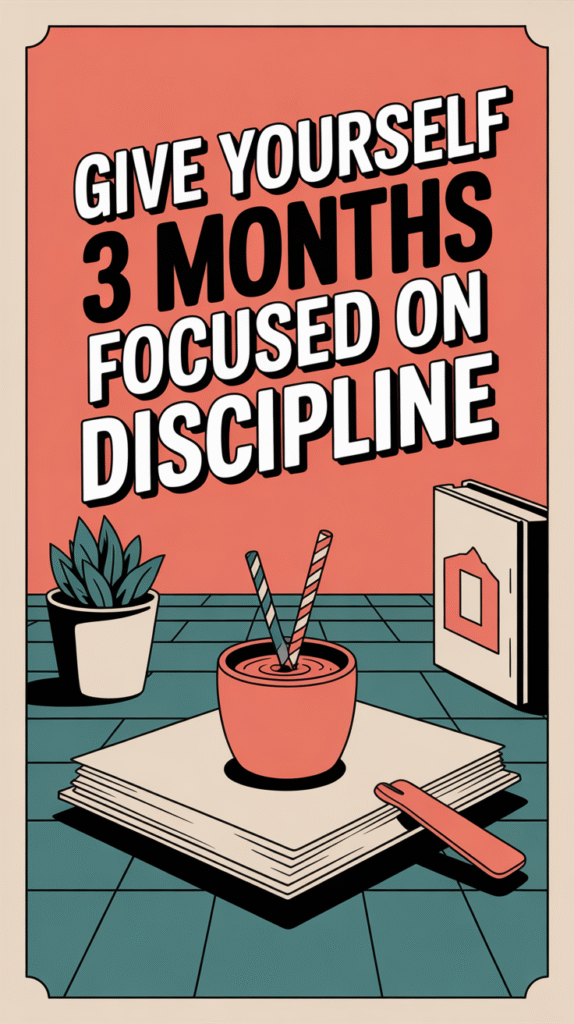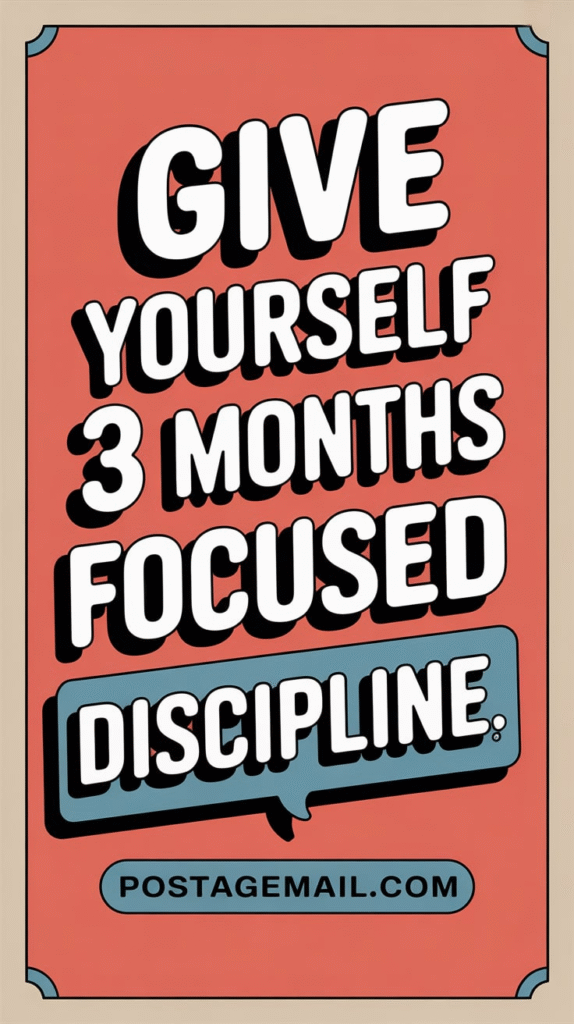If you give yourself just three months with a clear plan, you can go from scattered and reactive to steady and in control. This program breaks that transformation into three focused 30-day blocks — a mental reboot, disciplined action, and identity-level mastery. Ready? Let’s build the kind of discipline that actually sticks.

Why a 3-Month Discipline Program Works
The science of habit formation (short primer)
Habits form through repetition, cue → routine → reward. Neural pathways strengthen each time you repeat an action. Thirty to ninety days is a realistic window: 30 days to start, 60 to stabilize, 90 to make it feel natural. That’s not magic — it’s biology and consistent practice.
Why three months is the sweet spot
Three months is long enough to build momentum and short enough to stay motivated. It forces regular review and adjustment, so you don’t wander aimlessly. Think of this period as a bootcamp: intense, purposeful, and transformational.
How to Use This Program: Rules & Mindset
Simple rules to follow
- Choose one non-negotiable wake-up time.
- Pick three small daily non-negotiables.
- Track impulses and distractions in real time.
- Do weekly reflections — not for judgment, but for learning.
The accountability framework
Tell one person what you’re doing (friend, partner, coach), or use a public tracker. Accountability doesn’t have to be harsh; it’s the gentle pressure that keeps tiny promises from becoming forgettable.
Month 1: Mental Reboot — Master the Basics
Theme: Build self-awareness and stop willpower leaks
This month is about plugging holes. Willpower is finite if you treat it like unlimited. The aim here is to reduce friction and save mental energy for the things that truly matter.
Core Focus: Wake-up time & Daily Non-Negotiables
- Wake-up time: Pick one time and stick with it — weekdays and weekends. Consistency anchors your day.
- Daily non-negotiables: Choose three easy, meaningful habits, for example:
- Make your bed.
- Drink 1L water within a couple hours of waking.
- Journal for 5 minutes.
Track impulses: How and why
Every time you notice procrastination or a distracting pull (like scrolling), write it down. Quick note: what you wanted to avoid, what tempted you, and how you felt. This builds self-awareness — the single most powerful tool for change.
Mini Challenges for Month 1
- 3-day no sugar or junk food: Reset cravings and sharpen willpower.
- 7-day social media limiter: 2 hours max per day. See where your attention goes.
Weekly Reflection Prompts
- What did I avoid this week?
- What am I proud of?
Answer honestly and briefly. Use this to tweak the next week — not to punish yourself.

Month 1 Goal: What success looks like
Success in Month 1 is not perfection. It’s structure, clarity, and starting to keep promises to yourself. If you consistently hit your three non-negotiables and your wake-up time, you’ve won.
Month 1 Practical Tips & Example Routine
Morning routine sample
- Wake up (same time).
- Make your bed.
- Drink a glass of water (aim for 1L across the morning).
- 5-minute journal (what’s one win for today?).
- 10-minute light movement (stretch or walk).
Evening routine sample
- Quick reflection: what went well? one tweak?
- Prep for the morning (clothes, water bottle, notebook).
- 30-min tech wind-down before bed.
Month 2: Discipline in Action — Push Yourself Daily
Theme: Do hard things, consistently
Now we take the structure and turn it into practice. The point is to seek out resistance and show up anyway.
Core Focus: Deep work & movement
- Daily 1-hour deep work: Pick one meaningful task and protect that hour — no messages, no tabs, no interruptions.
- Workout discipline: Move your body daily. Not for aesthetics — for clarity. Even a 20-minute walk counts.
Deny gratification: small wins add up
Practice the word “later.” Delay small pleasures: snacks, social scrolling, instant purchases. Each delay grows your impulse control muscle.
Mini Challenges for Month 2
- Cold showers 3x/week: Brief discomfort that primes resilience.
- 7-day no snooze button: Wake and move — immediately.
- Pick a discipline role model: Study one person who embodies the habits you want.
Weekly Challenge: Embrace discomfort
Each week, do one thing just because it’s uncomfortable — a hard conversation, a long reading session, an early solo trip. Purposefully choosing discomfort trains you to act despite fear.
Month 2 Goal: Rewiring your response to resistance
If, by the end of Month 2, you’re protecting a deep work hour and you move your body daily more often than not, you’re rewiring the part of your brain that defaults to comfort.
Month 2 Practical Tools & Tricks
How to protect a 1-hour deep work block
- Turn phone on Do Not Disturb.
- Use a website blocker for distracting sites.
- Set a clear micro-goal for the hour (e.g., 500 words, one report section).
- Use the Pomodoro if you like (25/5), but keep one solid hour sometime in the day.
Quick daily workouts that stick
- 20-minute walk with no podcast — just notice.
- 10-minute bodyweight circuit (push-ups, squats, planks).
- Stretch + mobility flow for 15 minutes.
Month 3: Self-Mastery — Lock It In, Level It Up
Theme: Discipline as identity
This is where discipline stops being something you do and starts being who you are. Your choices align with your self-image.
Core Focus: Streaks, time audits, mindset shift
- Discipline Streak Tracker: Keep a visible streak for key habits. Streaks create psychological momentum.
- Time Audit: Track where every hour goes for a week. Prime insight: time wasted is rarely intentional.
- Discipline = Freedom Mindset: Reframe structure as power; it frees you from decision fatigue and chaos.
Mini Challenges for Month 3
- 30-day habit streak: Choose your toughest habit and run a full streak.
- Teach or mentor someone: Explaining your process deepens mastery.
- Create a “future you” vision board or daily mantra: Visual cues anchor identity.
Month 3 Goal: Make discipline your default
By the end, discipline should feel like a muscle you use without overthinking. You’ll have tools to recover quickly when you slip.
Month 3 Practical Steps
How to run a time audit
- For 7 days, log every 30-minute block.
- At the end of each day, categorize blocks: Focus, Admin, Leisure, Sleep, Transit.
- Identify time sinks and one change to reclaim 2–3 hours per week.
Teaching as the ultimate test
When you teach someone else your habits, gaps in your understanding appear. Mentoring forces clarity and consolidates learning. Plus, you reinforce your identity by helping others.
Common Roadblocks and How to Fix Them
Burnout vs. consistent fatigue
If you feel exhausted, check sleep, nutrition, and workload. Discipline isn’t punishment. Scale back intensity, not the structure. Replace an hour of deep work with a lighter task for a week if needed — keep the habit, not the struggle.
Perfectionism and “all or nothing” thinking
Perfectionism kills momentum. Missed one day? Restart today. Small, repeated actions beat spectacular but short-lived bursts.
Slippage and relapse: recovery tactics
Slip-ups happen. Use them as data, not identity. Quick recovery plan: 1) Acknowledge, 2) Journal what went wrong, 3) Recommit with one immediate action (e.g., do one push-up, write one line).
Tools, Apps & Templates to Make It Easier
Habit trackers and timers
- A simple bullet journal works.
- Apps: habit trackers, pomodoro timers, website blockers.
- Visual trackers (calendar Xs) are highly motivating.
Journals and reflection templates
Keep a weekly reflection with prompts: wins, obstacles, one tweak. Templates reduce decision friction and make reflection fast.
Real-Life Examples & Micro Case Studies
From morning chaos to reliable mornings
Meet Aisha: chaotic mornings, late to everything. Month 1 — consistent wake time and one non-negotiable: make the bed. Month 2 — added a 1-hour deep work before breakfast. Month 3 — ran a 30-day habit streak and mentored a friend. Outcome: more calm, better productivity, and fewer decision-based bleeds into the day.
From distraction to deep work
Sam used to snack-scroll for hours. He tracked impulses, limited social media, and protected his deep hour. After Month 2, his output doubled. The habit stuck because small, meaningful wins reinforced his identity as “someone who finishes hard things.”
How to Keep Momentum After 3 Months
Maintaining streaks without rigidity
Streaks are powerful, but don’t let them become prison. If life gets complex, prioritize the spirit of the practice. Miss a day and return. Use “minimum effective dose”: what is the smallest action that preserves the habit?
Leveling up: new challenges and compounding wins
Once discipline is stable, introduce a new area: eating, finance, relationships, or skill-building. Small gains compound — 1% better each day becomes huge over time.
Quick 30-Second Discipline Hacks
- Place your phone in another room during deep work.
- Put a water bottle by your bedside to drink first thing.
- Use visual cues: sticky notes, a visible habit calendar.
- Set a single daily intention each morning.
- Reward tiny wins (tea, 5-min break, celebratory stretch).
Conclusion
Discipline isn’t about harsh rules or brutal self-denial. It’s a deliberate, compassionate redesign of your daily environment and choices so you can do the things that matter. Give yourself three months — start with awareness in Month 1, push into consistent practice in Month 2, and lock it in as identity in Month 3. Build structure, collect small wins, and watch your life create the momentum you want. You don’t need willpower to be a different person — you need a better plan and the patience to follow it.
FAQs
Q1: What if I miss several days early on?
Missing days is normal. Treat slips as information. Identify one tiny action you can do right now and restart. The fastest recovery is immediate recommitment, not wallowing.
Q2: How strict should I be about the wake-up time?
Aim for consistency. Allow occasional deviations for special events, but keep the baseline within a 30–60 minute window. Consistency builds rhythm; rigidity breeds resentment.
Q3: Can I focus on more than three daily non-negotiables?
Start with three. It keeps the load manageable and ensures focus. Once those stick, you can add more, or swap them for higher-impact habits.
Q4: What if I work night shifts or have irregular hours?
Use the same principles but adapt: pick a consistent “start of day” anchor that fits your schedule (e.g., wake-up after sleep, first meal). The core is consistency, not the clock.
Q5: How do I know which habit to choose for the 30-day streak in Month 3?
Pick the habit that feels hardest but most impactful. It should be challenging enough to matter and specific enough to measure (e.g., “20 minutes of focused reading daily” instead of “read more”).

